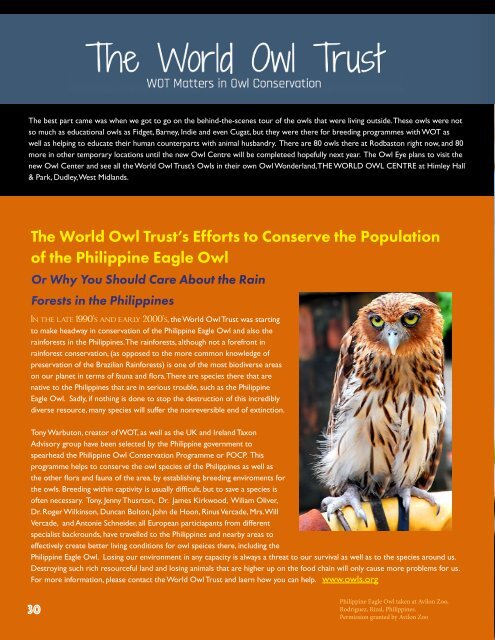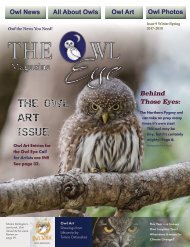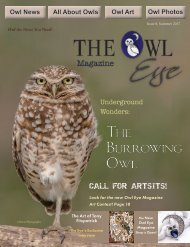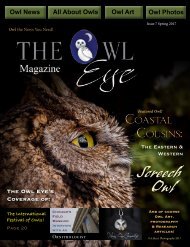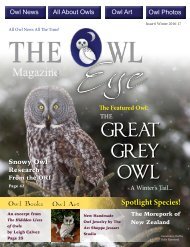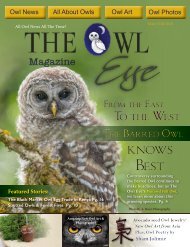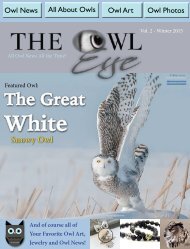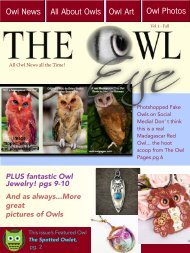owl_eye_issue4_online
You also want an ePaper? Increase the reach of your titles
YUMPU automatically turns print PDFs into web optimized ePapers that Google loves.
The best part came was when we got to go on the behind-the-scenes tour of the <strong>owl</strong>s that were living outside. These <strong>owl</strong>s were not<br />
so much as educational <strong>owl</strong>s as Fidget, Barney, Indie and even Cugat, but they were there for breeding programmes with WOT as<br />
well as helping to educate their human counterparts with animal husbandry. There are 80 <strong>owl</strong>s there at Rodbaston right now, and 80<br />
more in other temporary locations until the new Owl Centre will be completeed hopefully next year. The Owl Eye plans to visit the<br />
new Owl Center and see all the World Owl Trust’s Owls in their own Owl Wonderland, THE WORLD OWL CENTRE at Himley Hall<br />
& Park, Dudley, West Midlands.<br />
The World Owl Trust’s Efforts to Conserve the Population<br />
of the Philippine Eagle Owl<br />
Or Why You Should Care About the Rain<br />
Forests in the Philippines<br />
In the late 1990’s and early 2000’s, the World Owl Trust was starting<br />
to make headway in conservation of the Philippine Eagle Owl and also the<br />
rainforests in the Philippines. The rainforests, although not a forefront in<br />
rainforest conservation, (as opposed to the more common kn<strong>owl</strong>edge of<br />
preservation of the Brazilian Rainforests) is one of the most biodiverse areas<br />
on our planet in terms of fauna and flora. There are species there that are<br />
native to the Philippines that are in serious trouble, such as the Philippine<br />
Eagle Owl. Sadly, if nothing is done to stop the destruction of this incredibly<br />
diverse resource, many species will suffer the nonreversible end of extinction.<br />
Tony Warbuton, creator of WOT, as well as the UK and Ireland Taxon<br />
Advisory group have been selected by the Philippine government to<br />
spearhead the Philippine Owl Conservation Programme or POCP. This<br />
programme helps to conserve the <strong>owl</strong> species of the Philippines as well as<br />
the other flora and fauna of the area. by establishing breeding enviroments for<br />
the <strong>owl</strong>s. Breeding within captivity is usually difficult, but to save a species is<br />
often necessary. Tony, Jenny Thusrton, Dr. James Kirkwood, Wiliam Oliver,<br />
Dr. Roger Wilkinson, Duncan Bolton, John de Hoon, Rinus Vercade, Mrs. Will<br />
Vercade, and Antonie Schneider, all European particiapants from different<br />
specialist backrounds, have travelled to the Philippines and nearby areas to<br />
effectively create better living conditions for <strong>owl</strong> speices there, including the<br />
Philippine Eagle Owl. Losing our environment in any capacity is always a threat to our survival as well as to the species around us.<br />
Destroying such rich resourceful land and losing animals that are higher up on the food chain will only cause more problems for us.<br />
For more information, please contact the World Owl Trust and laern how you can help. www.<strong>owl</strong>s.org<br />
30<br />
Philippine Eagle Owl taken at Avilon Zoo,<br />
Rodriguez, Rizal, Philippines.<br />
Permission granted by Avilon Zoo


